Protein Dielectrophoresis: A Tale of Two Clausius-Mossottis—Or Something Else?
Abstract
:1. Introduction
2. Limitations of Macroscopic Electrostatics with Respect to Protein DEP
2.1. The Maxwell Cavity Susceptibility and [CM]macro
2.2. The β- and δ-Dispersions Associated with Protein Hydration
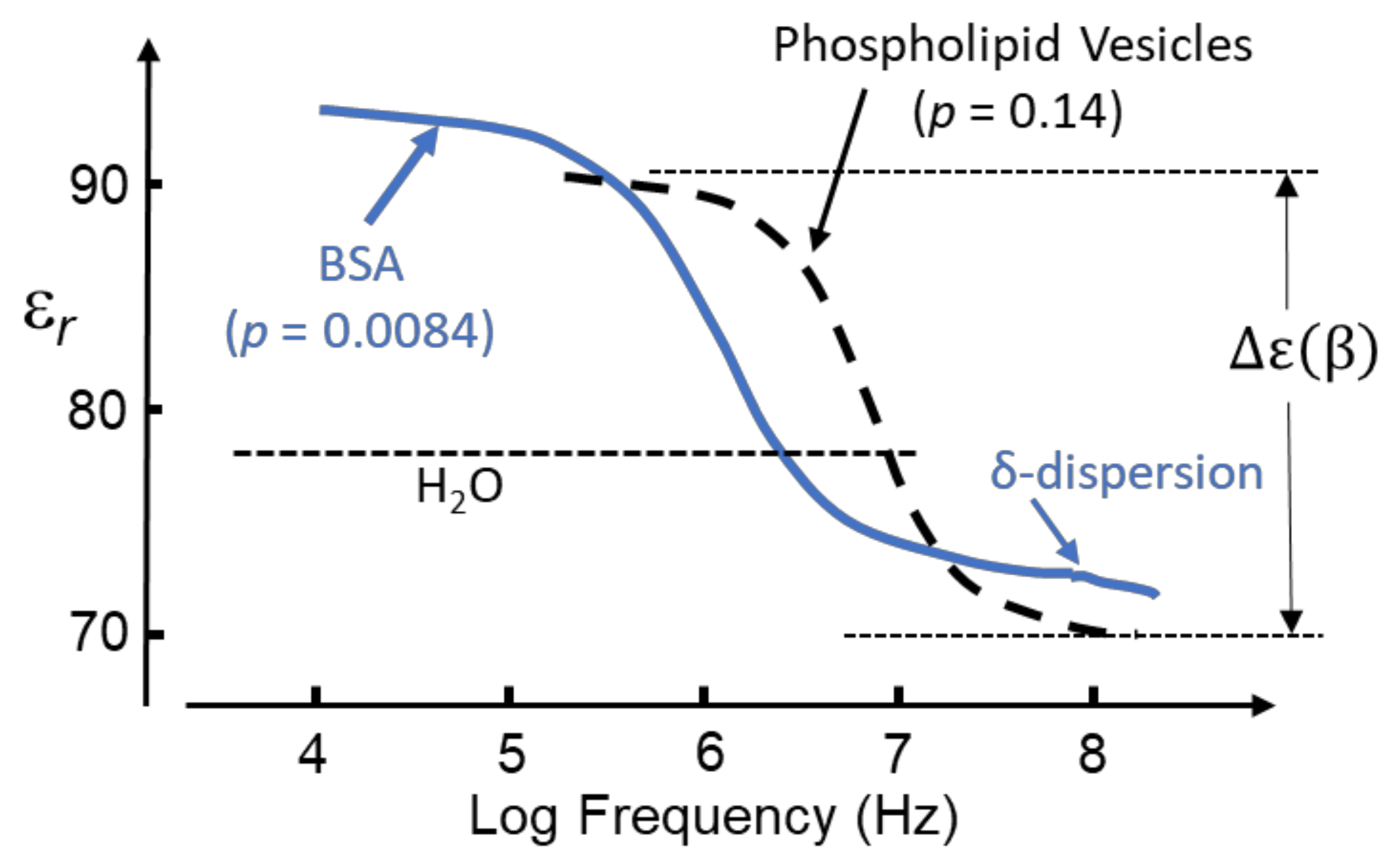
2.3. User-Friendly, Empirical, Theory for Protein DEP
3. Summary of Dielectric Theory of Relevance to Protein DEP
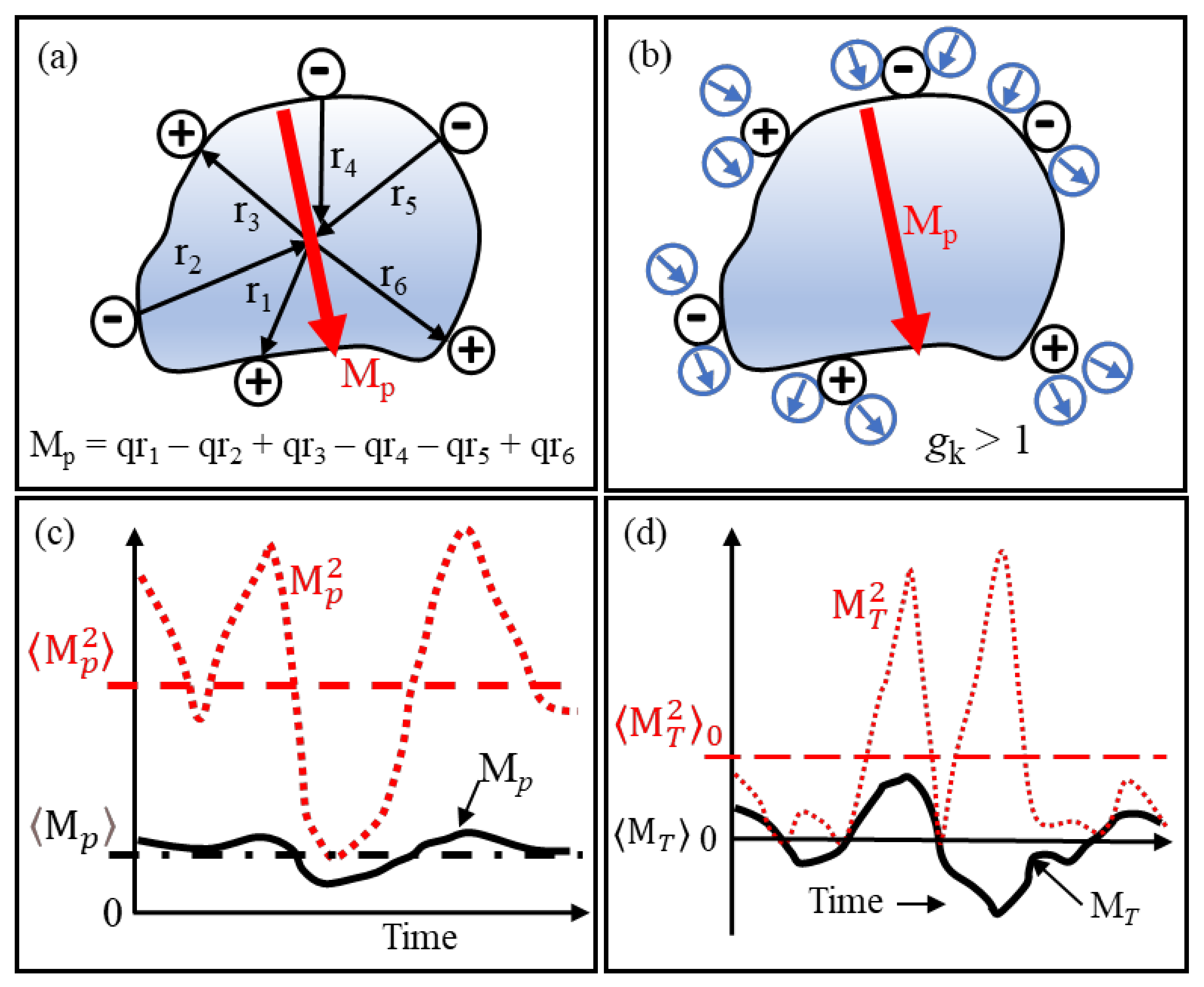
3.1. The Clausius–Mossotti Law, Lorentz Cavity Field and Debye’s Orientational Polarization

3.2. Maximum Size of a Lorentz Cavity
3.3. Onsager’s Reaction Field [57] and Kirkwood’s Correlation Factor [58,59]
3.4. Fröhlich’s Theory Relating Permittivity and Spontaneous Polarization
3.5. South and Grant’s Theory of Protein Dipole Relaxation
4. Heyden and Matyushov’s Theory and MD Simulations
4.1. The Theory
4.2. Molecular Dynamics Studies
5. Something Else?
5.1. eDEP
- Electrothermal fluid motion can disrupt DEP at frequencies below ~10 KHz [80].
- Below ~1 kHz electrode polarization should be taken into account [81].
- Below ~100 Hz the electrophoresis and DEP of bacteria are superimposed and enhance positive DEP [81].
- Below ~100 Hz the DEP of mammalian cells rises rapidly with decreasing frequency. Neuraminidase treatment confirms this is associated with cell surface charge [82].
“although we may be seeing the combination of agglomeration and DEP at the low-frequency region, agglomeration is not a prerequisite for molecular accumulation, and DEP does occur with protein monomers.”
- (i)
- Validate (e.g., through gel chromatography) that the samples are protein monomers.
- (ii
- Limit protein concentrations to below ~0.1 μg/mL (i.e., less than 7 μM for many candidate proteins).
- (iii)
- Adopt 1 mS/m as the upper limit for the aqueous solvent conductivity.
5.2. iDEP
6. Concluding Comments
Funding
Acknowledgments
Conflicts of Interest
References
- Heyden, M.; Matyushov, D.V. Dielectrophoresis of proteins in solution. J. Phys. Chem. B 2020, 124, 11634–11647. [Google Scholar] [CrossRef] [PubMed]
- Washizu, M.; Suzuki, S.; Kurosawa, O.; Nishizaka, T.; Shinohara, T. Molecular dielectrophoresis of biopolymers. IEEE Trans. Ind. Appl. 1994, 30, 835–843. [Google Scholar] [CrossRef]
- Pethig, R. Limitations of the Clausius-Mossotti function used in dielectrophoresis and electrical impedance studies of biomacromolecules. Electrophoresis 2019, 40, 2575–2583. [Google Scholar] [CrossRef] [PubMed]
- Hölzel, R.; Pethig, R. Protein dielectrophoresis: Status of experiments and an empirical theory. Micromachines 2020, 11, 533. [Google Scholar] [CrossRef] [PubMed]
- Hayes, M.A. Dielectrophoresis of proteins: Experimental data and evolving theory. Anal. Bioanal. Chem. 2020, 412, 3801–3811. [Google Scholar] [CrossRef]
- South, G.P.; Grant, E.H. Dielectric dispersion and dipole moment of myoglobin in water. Proc. R. Soc. Lond. A 1972, 328, 371–387. [Google Scholar]
- Green, G. An Essay on the Application of Mathematical Analysis to the Theories of Electricity and Magnetism; Wheelhouse T: Nottingham, UK, 1828. [Google Scholar]
- Faraday, M. Experimental Researches in Electricity; reprinted in Dover Publications; New York 1965; Taylor and Francis: London, UK, 1855; Volume 3, pp. 1839–1855. [Google Scholar]
- Mossotti, O.F. Discussione analitica sull’influenza che l’azione di un mezzo dielettrico ha sulla distribuzione dell’electricitá alla superficie di più corpi elettrici disseminati in esso. Mem. Mat. Fis. Soc. Ital. Sci. 1850, 24, 49–74. [Google Scholar]
- Clausius, R. Die mechanische Wärmetheorie, Zweiter Band: Die mechanische Behandlung der Electricität; Vieweg: Braunschweig, Germany, 1879; pp. 62–97. [Google Scholar]
- Abraham, M.; Föppl, A. Einführung in die Maxwellsche Theorie der Elektrizität, 3rd ed.; Teubner: Leipzig, Germany, 1907; Chapter 3. [Google Scholar]
- Becker, R. The Classical Theory of Electricity and Magnetism; Hefner Publ. Co.: New York, NY, USA, 1932. [Google Scholar]
- Pohl, H.A. Dielectrophoresis: The Behavior of Neutral Matter in Nonuniform Electric Fields; Cambridge University Press: Cambridge, UK, 1978. [Google Scholar]
- Jones, T.B. Electromechanics of Particles; Cambridge University Press: Cambridge, UK, 1995. [Google Scholar]
- Stratton, J.A. Electromagnetic Theory; McGraw-Hill: New York, NY, USA, 1941. [Google Scholar]
- Pethig, R. Dielectrophoresis: Theory, Methodology and Biological Applications; John Wiley & Sons: Hoboken, NJ, USA, 2017. [Google Scholar]
- Arnold, W.M.; Schwan, H.P.; Zimmermann, U. Surface conductance and other properties of latex particles measured by electrorotation. J. Phys. Chem. 1987, 91, 5093–5098. [Google Scholar] [CrossRef]
- Debye, P. Polar Molecules; The Chemical Catalog Co., Dover Publications: New York, NY, USA, 1929. [Google Scholar]
- Fröhlich, H. Theory of Dielectrics, 2nd ed.; Clarendon Press: Oxford, UK, 1958. [Google Scholar]
- Maxwell, J.C. A Treatise on Electricity and Magnetism, 3rd ed.; Clarendon Press: Oxford, UK, 1891; Volume 1. [Google Scholar]
- Lapizco-Encinas, B.H.; Ozuna-Chacón, S.; Rito-Palomares, M. Protein manipulation with insulator-based dielectrophoresis and direct current electric fields. J. Chromat. A 2008, 1206, 45–51. [Google Scholar] [CrossRef]
- Zhang, P.; Liu, Y. DC biased low-frequency insulating constriction dielectrophoresis for protein biomolecules concentration. Biofabrication 2017, 9, 045003. [Google Scholar] [CrossRef]
- Liu, Y.; Hayes, M.A. Orders of magnitude larger force demonstrated for dielectrophoresis of proteins enabling high-resolution separations based on new mechanisms. Anal. Chem. 2021, 93, 1352–1359. [Google Scholar] [CrossRef] [PubMed]
- Hölzel, R.; Pethig, R. Protein dielectrophoresis: Key dielectric parameters and evolving theory. Electrophoresis 2021, 42, 513–538. [Google Scholar] [CrossRef] [PubMed]
- Kwak, T.J.; Jung, H.; Allen, B.D.; Demirel, M.C.; Chang, W.-J. Dielectrophoretic separation of randomly shaped protein particles. Sep. Purif. Technol. 2021, 262, 118280. [Google Scholar] [CrossRef]
- Camacho-Alanis, F.; Gan, L.; Ros, A. Transitioning streaming to trapping in DC insulator based dielectrophoresis for biomolecules. Sens. Actuators B Chem. 2012, 173, 668–675. [Google Scholar] [CrossRef] [PubMed] [Green Version]
- Nakano, A.; Camacho-Alanis, F.; Ros, A. Insulator-based dielectrophoresis with β-galactosidase in nanostructured devices. Analyst 2015, 140, 860–868. [Google Scholar] [CrossRef] [Green Version]
- Matyushov, D. Manual for Theoretical Chemistry; World Scientific: Hackensack, NJ, USA, 2021. [Google Scholar]
- Shannon, G.; Marples, C.R.; Toofany, R.D.; Williams, P.M. Evolutionary drivers of protein shape. Sci. Rep. 2019, 9, 11873. [Google Scholar] [CrossRef]
- Gimsa, J.; Wachner, D. A polarization model overcoming the geometric restrictions of the Laplace solution for spheroidal cells: Obtaining new equations for field-induced forces and transmembrane potential. Biophys. J. 1999, 77, 1316–1326. [Google Scholar] [CrossRef] [Green Version]
- Simonson, T. Dielectric constant of cytochrome-c from simulations in a water droplet including all electrostatic interactions. J. Am. Chem. Soc. 1998, 120, 4875–4876. [Google Scholar] [CrossRef]
- Bone, S.; Pethig, R. Dielectric studies of protein hydration and hydration-induced flexibility. J. Mol. Biol. 1982, 157, 571–575, Erratum in 1985, 181, 323–326. [Google Scholar] [CrossRef]
- Cao, Z.; Zhu, Y.; Liu, Y.; Dong, S.; Chen, X.; Bai, F.; Song, S.; Fu, J. Dielectrophoresis-based protein enrichment for a highly sensitive immunoassay using Ag/SiO2 nanorod arrays. Small 2018, 14, 17032265. [Google Scholar] [CrossRef]
- Laux, E.M.; Knigge, X.; Bier, F.F.; Wenger, C.; Hölzel, R. Dielectrophoretic immobilization of proteins: Quantification by atomic force microscopy. Electrophoresis 2015, 36, 2094–2101. [Google Scholar] [CrossRef] [PubMed]
- Clarke, R.W.; White, S.S.; Zhou, D.J.; Ying, L.M.; Klenerman, D. Trapping of proteins under physiological conditions in a nanopipette. Angew. Chem. Int. Ed. 2005, 44, 3747–3750. [Google Scholar] [CrossRef] [PubMed]
- Liao, K.T.; Tsegaye, M.; Chaurey, V.; Chou, C.F.; Swami, N.S. Nano-constriction device for rapid protein preconcentration in physiological media through a balance of electrokinetic forces. Electrophoresis 2012, 33, 1958–1966. [Google Scholar] [CrossRef] [PubMed]
- Chaurey, V.; Rohani, A.; Su, Y.H.; Liao, K.T.; Chou, C.F.; Swami, N.S. Scaling down constriction-based (electrodeless) dielectrophoresis devices for trapping nanoscale bioparticles in physiological media of high-conductivity. Electrophoresis 2013, 34, 1097–1104. [Google Scholar] [CrossRef] [PubMed]
- Staton, S.J.R.; Jones, P.V.; Ku, G.; Gilman, S.D.; Kheterpal, I.; Hayes, M.A. Manipulation and capture of A beta amyloid fibrils and monomers by DC insulator gradient dielectrophoresis (DC-iGDEP). Analyst 2012, 137, 3227–3229. [Google Scholar] [CrossRef] [PubMed]
- Zheng, L.; Brody, J.P.; Burke, P.J. Electronic manipulation of DNA, proteins, and nanoparticles for potential circuit assembly. Biosens. Bioelectron. 2004, 20, 606–619. [Google Scholar] [CrossRef] [PubMed]
- Moser, P.; Squire, P.G.; O’Konski, C.T. Electric polarization in proteins—Dielectric dispersion and Kerr effect studies of isoionic bovine serum albumin. J. Phys. Chem. 1966, 70, 744–756. [Google Scholar] [CrossRef]
- Essex, C.G.; Symonds, M.S.; Sheppard, R.J.; Grant, E.H.; Lamote, R.; Soetewey, F.; Rosseneu, M.Y.; Peeters, H. Five-component dielectric dispersion in bovine serum albumin solution. Phys. Med. Biol. 1977, 22, 1160–1167. [Google Scholar] [CrossRef]
- Schwan, H.P.; Takashima, S.; Miyamoto, V.K.; Stoeckenius, W. Electrical properties of phospholipid vesicles. Biophys. J. 1970, 10, 1102–1119. [Google Scholar] [CrossRef] [Green Version]
- Fischer, H.; Polikarpov, I.; Craievich, A.F. Average protein density is a molecular-weight-dependent function. Protein Sci. 2004, 13, 2825–2827. [Google Scholar] [CrossRef]
- Miura, N.; Asaka, N.; Shinyashiki, N.; Mashimo, S. Microwave dielectric study on bound water of globule proteins in aqueous solution. Biopolymers 1994, 34, 357–364. [Google Scholar] [CrossRef]
- Wolf, M.; Gulich, R.; Lunkenheimer, P.; Loidl, A. Relaxation dynamics of a protein solution investigated by dielectric spectroscopy. Biochim. Biophys. Acta Proteins Proteom. 2012, 1824, 723–730. [Google Scholar] [CrossRef] [PubMed] [Green Version]
- Reynolds, J.A.; Hough, J.M. Formulae for dielectric constant of mixtures. Proc. Phys. Soc. B 1957, 70, 769–775. [Google Scholar] [CrossRef]
- Raicu, V. Dielectric Relaxation in Biological Systems; Raicu, V., Feldman, Y., Eds.; Oxford University Press: New York, NY, USA, 2015; pp. 60–83. [Google Scholar]
- Bakewell, J.G.; Hughes, M.P.; Milner, J.J.; Morgan, H. Dielectrophoretic manipulation of avidin and DNA. In Proceedings of the 20th Annual International Conference of the IEEE Engineering in Medicine and Biology Society, Hong Kong, China, 1 November 1998; Volume 20, pp. 1079–1082. [Google Scholar]
- Kim, H.J.; Kim, J.; Yoo, Y.K.; Lee, J.H.; Park, J.H.; Wang, K.S. Sensitivity improvement of an electrical sensor achieved by control of biomolecules based on the negative dielectrophoretic force. Biosens. Bioelectron. 2016, 85, 977–985. [Google Scholar] [CrossRef] [PubMed]
- Lorentz, H.A. The Theory of Electrons; Teubner: Leipzig, Germany, 1916. [Google Scholar]
- Langevin, P. Sur la théorie du movement brownien. C. R. Acad. Sci. Paris 1908, 146, 530–533. [Google Scholar]
- Warshel, A. Computer Modeling of Chemical Reactions in Enzymes and Solutions; Wiley: New York, NY, USA, 1991. [Google Scholar]
- Papazyan, A.; Warshel, A. Continuum and dipole-lattice models of solvation. J. Phys. Chem. B 1997, 101, 11254–11264. [Google Scholar] [CrossRef]
- Scheider, W.; Dintzis, H.M.; Oncley, J.L. Changes in the electric dipole vector of human serum albumin due to complexing with fatty acids. Biophys. J. 1976, 16, 417–431. [Google Scholar] [CrossRef] [Green Version]
- Ramshaw, J.D. Existence of dielectric-constant in rigid-dipole fluids—Direct correlation-function. J. Chem. Phys. 1972, 57, 2684–2690. [Google Scholar] [CrossRef] [Green Version]
- Ramshaw, J.D. Existence of the dielectric constant in rigid-dipole fluids: The functional-derivative approach. J. Chem. Phys. 1977, 66, 3134–3137. [Google Scholar] [CrossRef] [Green Version]
- Onsager, L. Electric moments of molecules in liquids. J. Am. Chem. Soc. 1936, 58, 1486–1493. [Google Scholar] [CrossRef]
- Kirkwood, J.G. The dielectric polarization of polar liquids. J. Chem. Phys. 1939, 7, 911–919. [Google Scholar] [CrossRef]
- Kirkwood, J.G. Molecular distribution in liquids. J. Chem. Phys. 1939, 7, 919–925. [Google Scholar] [CrossRef]
- Onsager, L. Autobiographical commentary. In Critical Phenomena in Alloys, Magnets and Superconductors; Mills, R.E., Ascher, E., Jaffee, R.I., Eds.; McGraw-Hill: New York, NY, USA, 1971; p. 20. [Google Scholar]
- Oster, G.; Kirkwood, J.G. The influence of hindered molecular rotation on the dielectric constants of water, alcohols and other polar liquids. J. Chem. Phys. 1943, 11, 175–178. [Google Scholar] [CrossRef]
- Hill, N.E. The theories of complex permittivity. J. Phys. C Solid State Phys. 1972, 5, 415–424. [Google Scholar] [CrossRef]
- Kreyszig, E. Advanced Engineering Mathematics, 10th ed.; John Wiley & Sons: New York, NY, USA, 2015. [Google Scholar]
- Onsager, L. Reciprocal relations in irreversible processes. Phys. Rev. 1931, 37, 405–426. [Google Scholar] [CrossRef]
- South, G.P.; Grant, E.H. Theory of dipolar relaxation in aqueous macromolecular solutions. Biopolymers 1974, 13, 1777–1789. [Google Scholar] [CrossRef]
- Scaife, B.K.P. Complex Permittivity; English Universities Press: London, UK, 1971. [Google Scholar]
- Oncley, J.L. The investigation of proteins by dielectric measurements. Chem. Rev. 1942, 30, 433–450. [Google Scholar] [CrossRef]
- Takashima, S.; Asami, K. Calculation and measurement of the dipole moment of small proteins: Use of protein data base. Biopolymers 1993, 33, 59–68. [Google Scholar] [CrossRef]
- Rudas, T.; Schröder, C.; Boresch, S.; Steinhauser, O. Simulation studies of the protein-water interface. II. Properties at the mesoscopic resolution. J. Chem. Phys. 2006, 124, 234908. [Google Scholar] [CrossRef]
- Schröder, C.; Rudas, T.; Boresch, S.; Steinhauser, O. Simulation studies of the protein-water interface. I. Properties at the molecular resolution. J. Chem. Phys. 2006, 124, 234907. [Google Scholar] [CrossRef]
- Martin, D.R.; Friesen, A.D.; Matyushov, D.V. Electric field inside a “Rossky cavity” in uniformly polarized water. J. Chem. Phys. 2011, 135, 084514. [Google Scholar] [CrossRef] [PubMed] [Green Version]
- Matyushov, D.V. Dipolar response of hydrated proteins. J. Chem. Phys. 2012, 136, 085102. [Google Scholar] [CrossRef] [PubMed] [Green Version]
- Seyedi, S.S.; Matyushov, D.V. Protein dielectrophoresis in solution. J. Phys. Chem. 2018, 122, 9119–9127. [Google Scholar] [CrossRef] [PubMed]
- Matyushov, D.V. Electrostatic solvation and mobility in uniform and non-uniform electric fields: From simple ions to proteins. Biomicrofluidics 2019, 13, 064106. [Google Scholar] [CrossRef] [PubMed]
- Knocks, A.; Weingärtner, H. The dielectric spectrum of ubiquitin in aqueous solution. J. Phys. Chem. B 2001, 105, 3635–3638. [Google Scholar] [CrossRef]
- Boresch, S.; Höchtl, P.; Steinhauser, O. Studying the dielectric properties of a protein solution by computer simulation. J. Phys. Chem. B 2000, 104, 8743. [Google Scholar] [CrossRef]
- Nandi, N.; Bagchi, B. Anomalous dielectric relaxation of aqueous protein solutions. J. Phys. Chem. A 1998, 102, 8217–8221. [Google Scholar] [CrossRef]
- Nandi, N.; Bagchi, B. Reply to the comment by S. Boresch and O. Steiner on the letter by N. Nandi and B. Bagchi entitled “Anomalous dielectric relaxation of aqueous protein solution”. J. Phys. Chem. A 2001, 105, 5509–5510. [Google Scholar] [CrossRef]
- Price, J.A.R.; Burt, J.P.H.; Pethig, R. Applications of a new optical technique for measuring the dielectrophoretic behavior of microorganisms. Biochim. Biophys. Acta 1988, 964, 221–230. [Google Scholar] [CrossRef]
- Inoue, T.; Pethig, R.; Al-Ameen, T.A.K.; Burt, J.P.H.; Price, J.A.R. Dielectrophoretic behavior of micrococcus-lysodeikticus and its protoplast. J. Electrost. 1988, 21, 215–223. [Google Scholar] [CrossRef]
- Burt, J.P.H.; Al-Ameen, T.A.K.; Pethig, R. An optical dielectrophoresis spectrometer for low-frequency measurements on colloidal suspensions. J. Phys. E Sci. Instrum. 1989, 22, 952–957. [Google Scholar] [CrossRef]
- Burt, J.P.H.; Pethig, R.; Gascoyne, P.R.C.; Becker, F.F. Dielectrophoretic characterization of Friend murine erythroleukaemic cells as a measure of induced-differentiation. Biochim. Biophys. Acta 1990, 1034, 93–101. [Google Scholar] [CrossRef]
- Pethig, R.; Huang, Y.; Wang, X.-B.; Burt, J.P.H. Positive and negative dielectrophoretic collection of colloidal particles using interdigitated castellated microelectrodes. J. Phys. D Appl. Phys. 1992, 25, 881–888. [Google Scholar] [CrossRef]
- Ramos, A.; Morgan, H.; Green, N.G.; Castellanos, A. AC electric-field-induced fluid flow in microelectrodes. J. Coll. Interface Sci. 1999, 217, 420–422. [Google Scholar] [CrossRef]
- Castellanos, A.; Ramos, A.; Gonzalez, A.; Green, N.G.; Morgan, H. Electrohydrodynamics and dielectrophoresis in microsystems: Scaling laws. J. Phys. D Appl. Phys. 2003, 36, 2584–2597. [Google Scholar] [CrossRef]
- Cummings, E.; Singh, A. Dielectrophoresis in microchips containing arrays of insulating posts: Theoretical and experimental results. Anal. Chem. 2003, 75, 4724–4731. [Google Scholar] [CrossRef]
- Lapizco-Encinas, B.H. Microscale electrokinetic assessments of proteins employing insulating structures. Curr. Opin. Chem. Eng. 2020, 29, 9–16. [Google Scholar] [CrossRef]
- Perez-Gonzalez, V.H. Particle trapping in electrically driven insulator-based microfluidics: Dielectrophoresis and induced charge electrokinetics. Electrophoresis 2021, 42, 2445–2464. [Google Scholar] [CrossRef]
- Lapizco-Encinas, B.H. The latest advances on nonlinear insulator-based electrokinetic microsystems under direct current and low-frequency alternating current fields: A review. Anal. Bioanal. Chem. 2022, 414, 885–905. [Google Scholar] [CrossRef]
- Xuan, X.C. Review of nonlinear electrokinetic flows in insulator-based dielectrophoresis: From induced charge to Joule heating effects. Electrophoresis 2022, 43, 167–189. [Google Scholar] [CrossRef]
- Kim, D.; Sonker, M.; Ros, A. Dielectrophoresis: From Molecular to Micrometer-Scale Analytes. Anal. Chem. 2019, 91, 277–295. [Google Scholar] [CrossRef] [PubMed]
- Lapizco-Encinas, B.H.; Simmons, B.A.; Cummings, E.B.; Fintschenko, Y. Insulator-based dielectrophoresis for the selective concentration and separation of live bacteria in water. Electrophoresis 2004, 25, 1695–1704. [Google Scholar] [CrossRef] [PubMed]
- Pethig, R.; Markx, G.H. Applications of dielectrophoresis in biotechnology. Trends Biotechnol. 1997, 15, 426–432. [Google Scholar] [CrossRef]
- Markx, G.H.; Huang, Y.; Zhou, X.-F.; Pethig, R. Dielectrophoretic characterization and separation of micro-organisms. Microbiology 1994, 140, 585–591. [Google Scholar] [CrossRef] [Green Version]
- Abdallah, B.G.; Roy-Chowdhury, S.; Coe, J.; Fromme, P.; Ros, A. High throughput protein nanocrystal fractionation in a microfluidic sorter. Anal. Chem. 2015, 87, 4159–4167. [Google Scholar] [CrossRef] [PubMed] [Green Version]
- Malekanfard, A.; Beladi-Behbahani, S.; Tzeng, T.-R.; Zhao, H.; Xuan, X. AC insulator-based dielectrophoretic focusing of particles and cells in an “infinite” microchannel. Anal. Chem. 2021, 93, 5947–5953. [Google Scholar] [CrossRef]
- Mata-Gomez, M.A.; Perez-Gonzalez, V.H.; Gallo-Villanueva, R.C.; Gonzalez-Valdez, J.; Rito-Palomares, M.; Martinez-Chapa, S.O. Modelling of electrokinetic phenomena for capture of PEGylated ribonuclease A in a microdevice with insulating structures. Biomicrofluidics 2016, 10, 033106. [Google Scholar] [CrossRef] [Green Version]
- Mata-Gomez, M.A.; Gallo-Villanueva, R.C.; Gonzalez-Valdez, J.; Martinez-Chapa, S.O.; Rito-Palomares, M. Dielectrophoretic behavior of PEGylated RNase A inside a microchannel with diamond-shaped insulating posts. Electrophoresis 2016, 37, 519–528. [Google Scholar] [CrossRef]
- Nakano, A.; Chao, T.-C.; Camacho-Alanis, F.; Ros, A. Immunoglobulin G and bovine serum albumin streaming dielectrophoresis in a microfluidic device. Electrophoresis 2011, 32, 2314–2322. [Google Scholar] [CrossRef]
- Garcia-Ruiz, J.M. Nucleation of protein crystals. J. Struct. Biol. 2003, 142, 22–31. [Google Scholar] [CrossRef]
- Asherie, N. Protein crystallization and phase diagrams. Methods 2004, 34, 266–272. [Google Scholar] [CrossRef] [PubMed]
- Nanev, C.N. Recent Insights into the Crystallization Process; Protein Crystal Nucleation and Growth Peculiarities; Processes in the Presence of Electric Fields. Crystals 2017, 7, 310. [Google Scholar] [CrossRef] [Green Version]
- Pareja-Rivera, C.; Cuellar-Cruz, M.; Esturau-Escofet, N.; Demitri, N.; Polentarutti, M.; Stojanoff, V.; Moreno, A. Recent advances in the understanding of the influence of electric and magnetic fields on protein crystal growth. Cryst. Growth Des. 2017, 1, 135–145. [Google Scholar] [CrossRef]
- Hill, N.; Lapizco-Encinas, B.H. On the use of correction factors for the mathematical modeling of insulator based dielectrophoretic devices. Electrophoresis 2019, 40, 2541–2552. [Google Scholar] [CrossRef]
- Tottori, S.; Misiunas, K.; Keyser, U.F. Nonlinear electrophoresis of highly charged nonpolarizable particles. Phys. Rev. Lett. 2019, 123, 014502. [Google Scholar] [CrossRef] [Green Version]
- Cardenas-Benitez, B.; Jind, B.; Gallo-Villanueva, R.C.; Martinez-Chapa, S.O.; Lapizco-Encinas, B.H.; Perez-Gonzalez, V.H. Direct current electrokinetic particle trapping in insulator-based microfluidics: Theory and experiments. Anal. Chem. 2020, 19, 12871–12879. [Google Scholar] [CrossRef]
- Antunez-Vela, S.; Perez-Gonzalez, V.H.; De Peña, A.; Lentz, C.J.; Lapizco-Encinas, B.H. Simultaneous determination of linear and nonlinear electrophoretic mobilities of cells and microparticles. Anal. Chem. 2020, 22, 14885–14891. [Google Scholar] [CrossRef]
- Ruz-Cuen, R.; de los Santos-Ramirez, J.M.; Cardenas-Benitez, B.; Ramirez-Murillo, C.J.; Miller, A.; Hakim, K.; Lapizco-Encinas, B.H.; Perez-Gonzalez, V.H. Amplification factor in DC insulator-based electrokinetic devices: A theoretical, numerical, and experimental approach to operation voltage reduction for particle trapping. Lab Chip 2021, 21, 4596–4607. [Google Scholar] [CrossRef]
- Quevedo, D.F.; Lentz, C.J.; de Peña, A.C.; Hernandez, Y.; Habibi, N.; Miki, R.; Lahann, J.; Lapizco-Encinas, B.H. Electrokinetic characterization of synthetic protein nanoparticles. Beilstein J. Nanotechnol. 2020, 11, 1556–1567. [Google Scholar] [CrossRef]
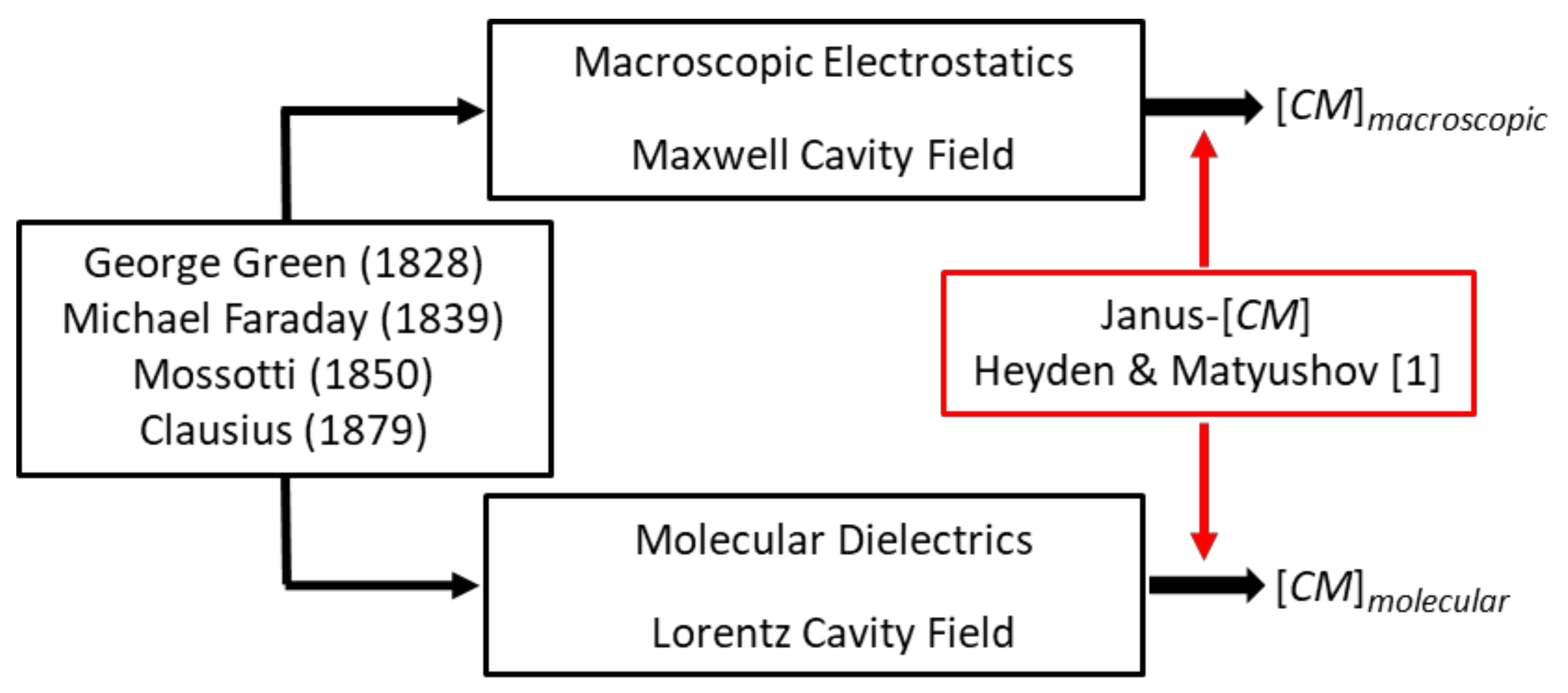
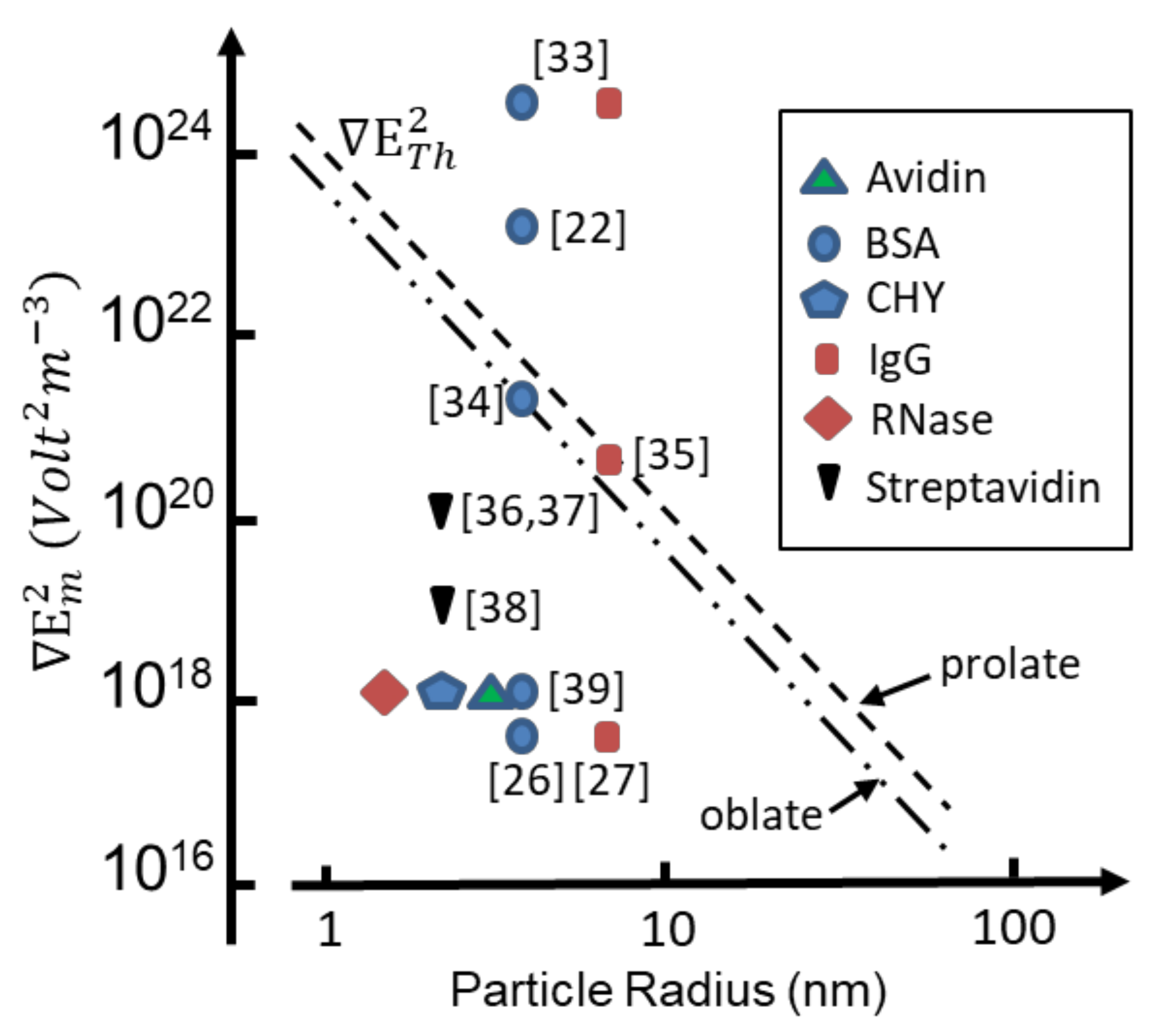
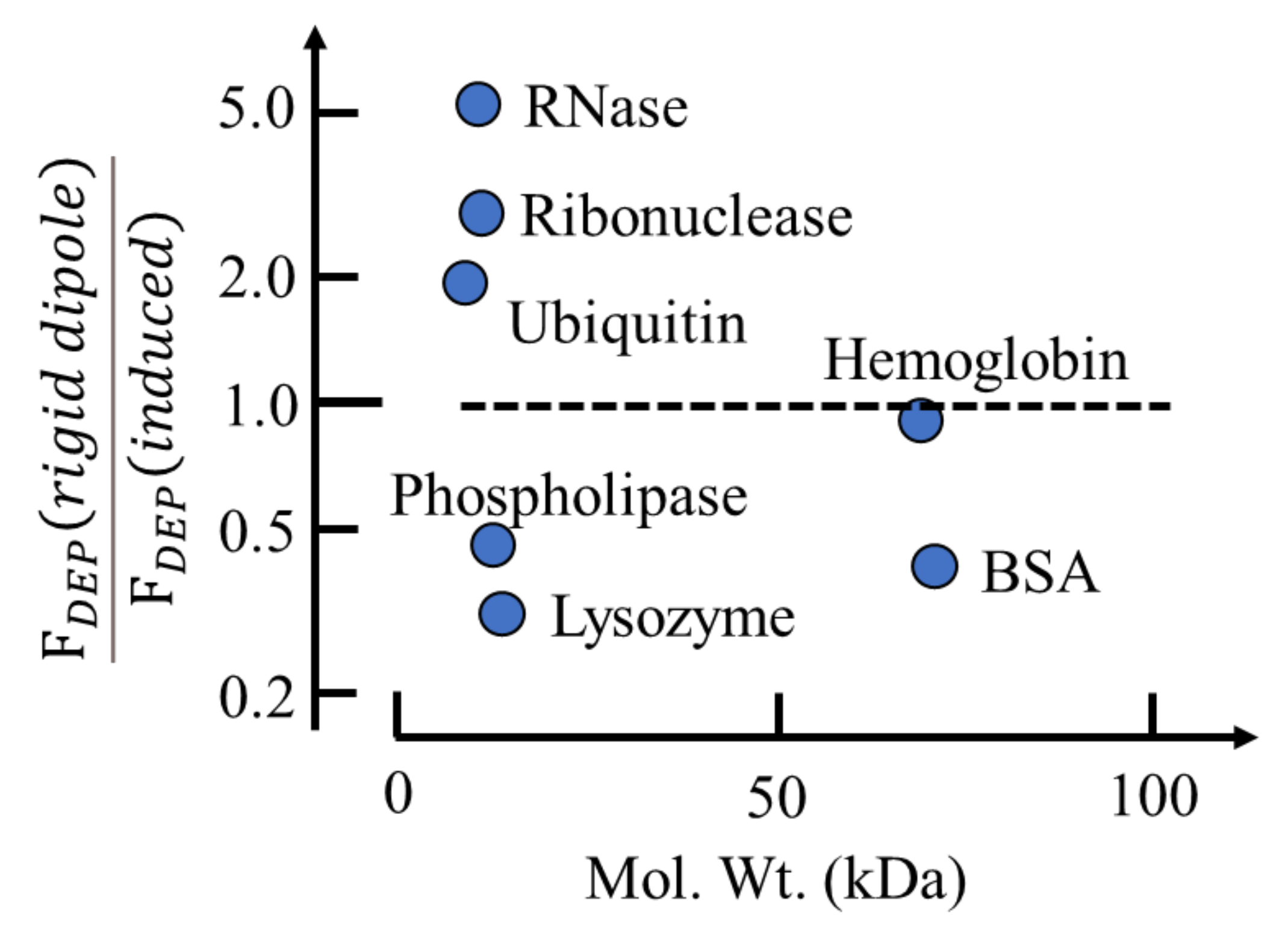
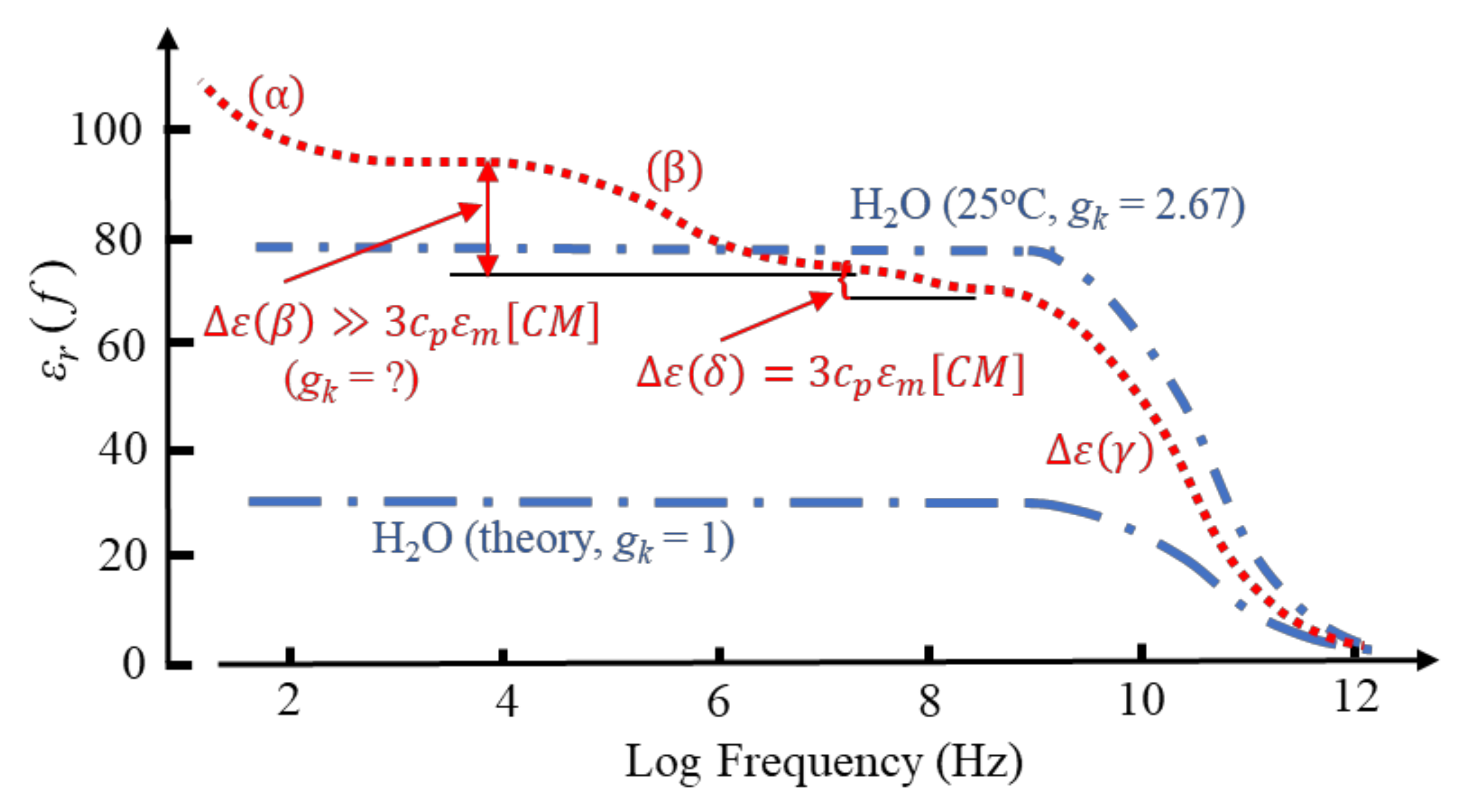
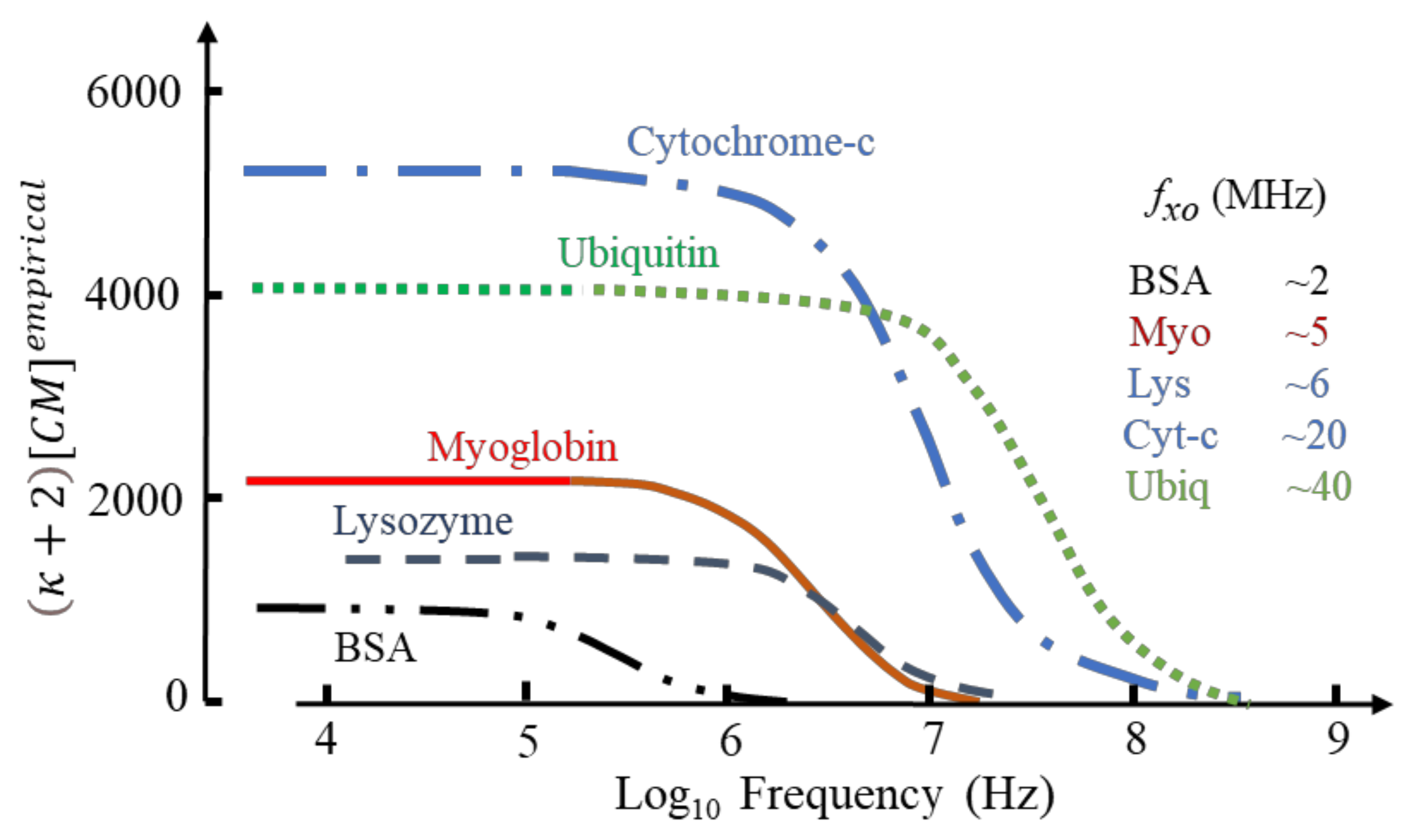

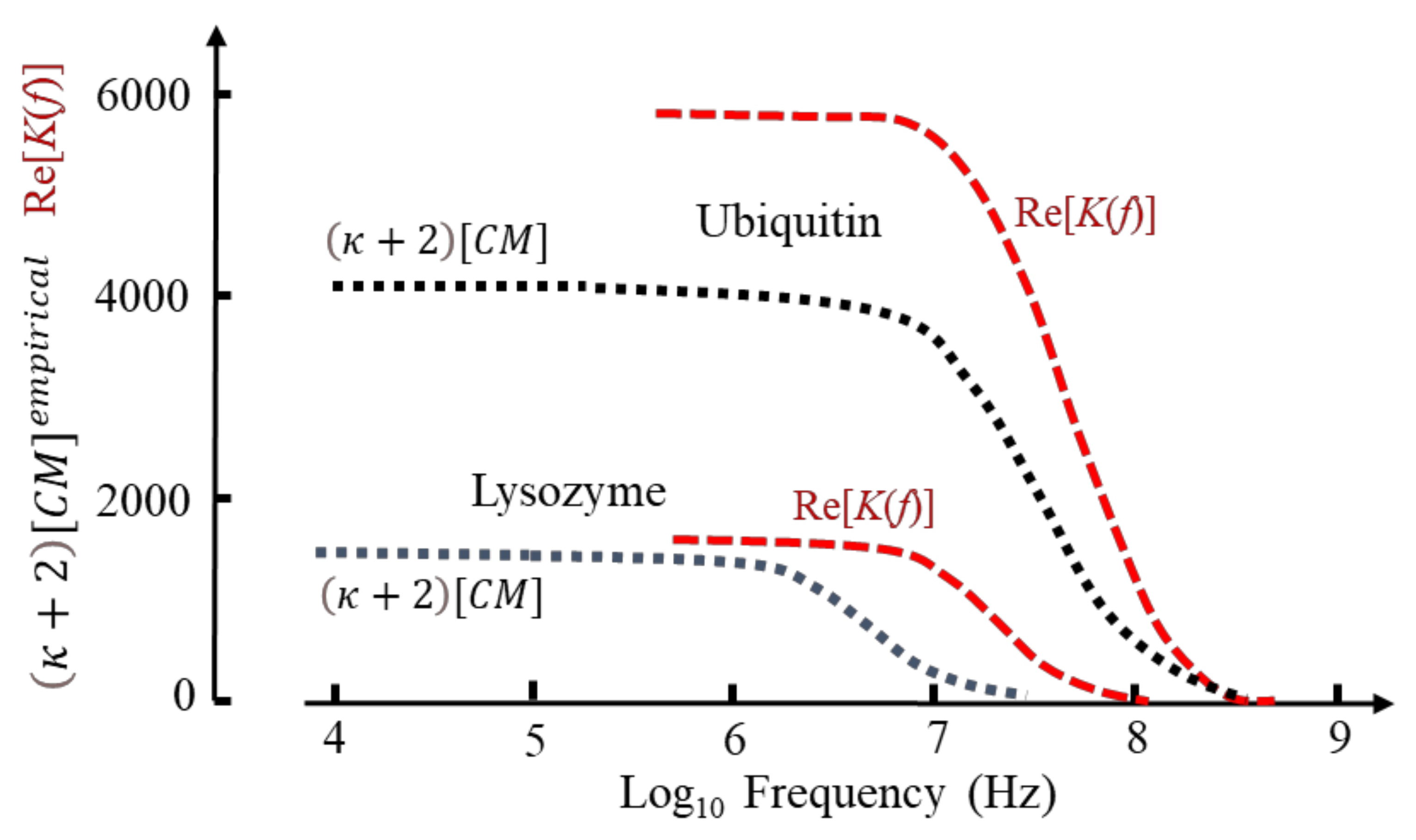
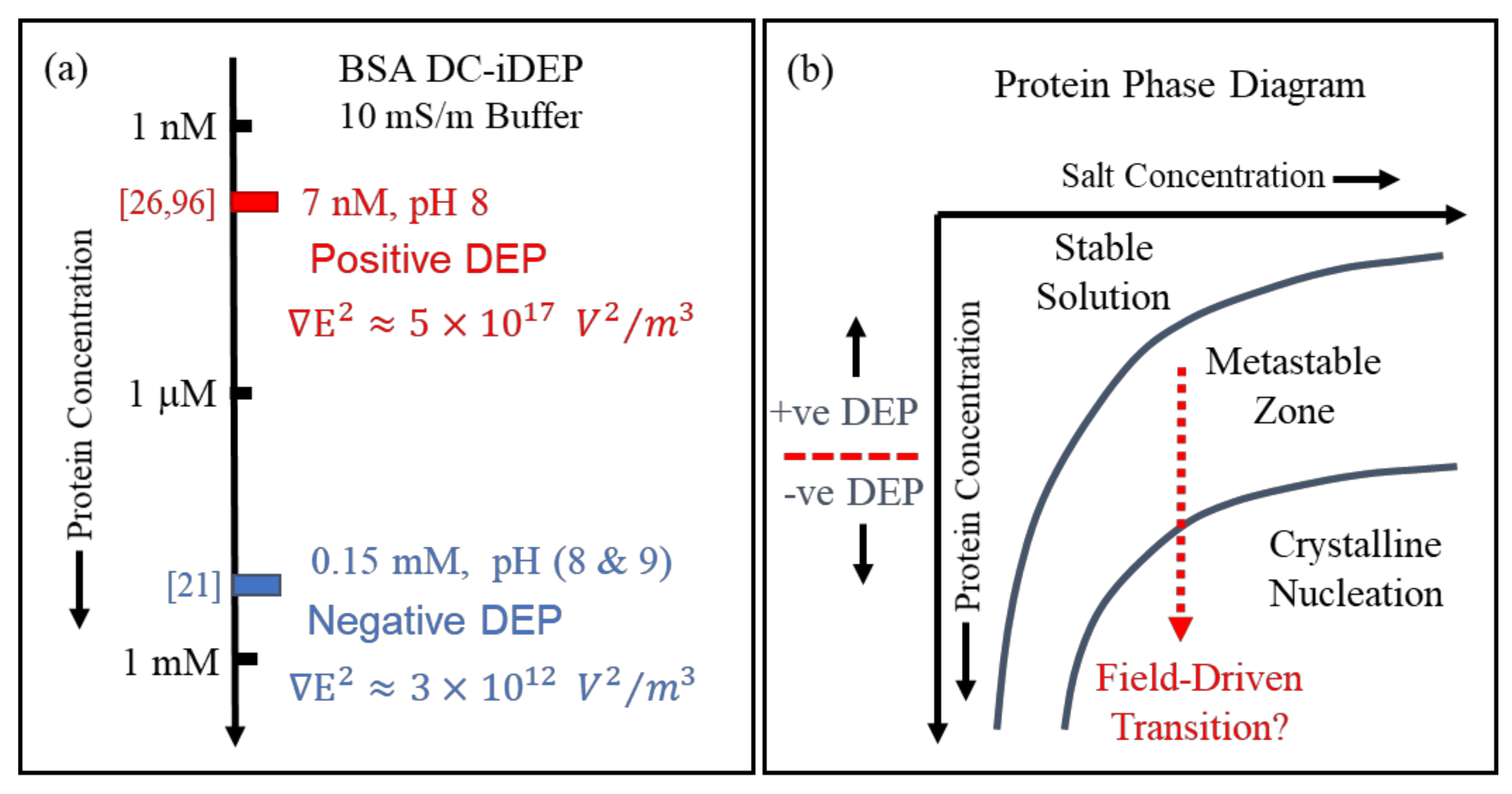
Publisher’s Note: MDPI stays neutral with regard to jurisdictional claims in published maps and institutional affiliations. |
© 2022 by the author. Licensee MDPI, Basel, Switzerland. This article is an open access article distributed under the terms and conditions of the Creative Commons Attribution (CC BY) license (https://creativecommons.org/licenses/by/4.0/).
Share and Cite
Pethig, R. Protein Dielectrophoresis: A Tale of Two Clausius-Mossottis—Or Something Else? Micromachines 2022, 13, 261. https://doi.org/10.3390/mi13020261
Pethig R. Protein Dielectrophoresis: A Tale of Two Clausius-Mossottis—Or Something Else? Micromachines. 2022; 13(2):261. https://doi.org/10.3390/mi13020261
Chicago/Turabian StylePethig, Ronald. 2022. "Protein Dielectrophoresis: A Tale of Two Clausius-Mossottis—Or Something Else?" Micromachines 13, no. 2: 261. https://doi.org/10.3390/mi13020261
APA StylePethig, R. (2022). Protein Dielectrophoresis: A Tale of Two Clausius-Mossottis—Or Something Else? Micromachines, 13(2), 261. https://doi.org/10.3390/mi13020261





